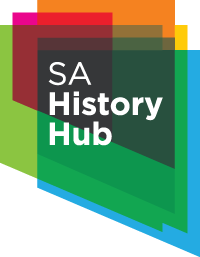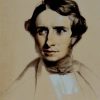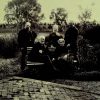At the first big promotional rally in Exeter Hall in London on 30 June 1834, John Morphett stood before more than 2,400 people and blithely and forthrightly declared: ‘In my heart I am now a South Australian’.
He was young, determined, fiercely independent and proud, and unlike so many of the others in this book sailed to the colony of South Australia as a private person. He held no portfolio within the South Australian Colonization Commission. As a young man he was not famous in any way. He paid his own fare on the Cygnet and yet somehow he was always at the centre of the action. That’s why he is named in the streets of Adelaide.
His name is memorialised in the north-western quadrant of the city of Adelaide, where Morphett Street embraces Light Square, and although it now runs right through to South Terrace, also embracing Whitmore Square, it used to stop at the intersection with Grote Street.
John Morphett was one of four on the Street Naming Committee who were not officials in the colony. They were invited by Resident Commissioner James Hurtle Fisher to join the Committee because they were heavily involved in some way as interested and respected colonists. Morphett was arguably a defacto official in the colony because he was acting as a purchasing agent for scores of emigrants and investors. There may have also been some form of quid pro quooperating because Fisher, who as Resident Commissioner initiated and formed the Committee, was also Morphett’s future father-in-law.
From the moment he committed himself to the project in 1834, Morphett took up with the key figures who were on this day mostly seated at the table. These were the believers and the aspirants known as the Adelphi Youngmen and who, now that they had arrived in the colony, were exercising their power. They included Robert Gouger, John Brown, Thomas Gilbert, Osmond Gilles, Fisher and Morphett. George Strickland Kingston was also part of this group, but he had been sent back to England with Lieutenant William George Field, ostensibly seeking more surveying equipment. Otherwise he too might have been present at the table.
When a young Morphett joined the project in 1834 he, like the others, could have sought appointment in the colony. However, he deliberately chose not to, preferring instead to set himself up as an independent agent, acting on behalf of intending colonists. In his few short years prior to emigrating, Morphett had several experiences in the Middle East and Egypt which served him well for his life in South Australia. His understanding of terrain, topography, soil fertility and pastoral potential was excellent.
After completing his schooling at both Plymouth and Highgate grammar schools, and still only 16, he took employment in the office of Henry Blanshard, ship brokers in London, and later joined the counting house of Wilson and Blanshard, which also operated out of foreign ports. At 21, Morphett resigned, some say because of a chest weakness, to join his mother’s cousin, John Gliddon, in Alexandria, Egypt.
Morphett joined a branch of Henry Blanshard in the thriving port. The strategic importance of Alexandria remained crucial to the stability of the Mediterranean and many British firms maintained maritime outposts there. This trip became part of Morphett’s ‘Grand Tour’. He first travelled slowly through France and Italy, learning to speak both languages fluently as he went. In Egypt he went into the counting house of Harris and Co., a large import and export business. The company supplied the large naval yards in Alexandria, where Mehmet Ali, the Pasha of Egypt, was building his navy. Presumably this is where Morphett first met Colonel William Light, who was also living in Alexandria. Light had been commissioned by the Pasha to secure British naval officers for his ships.
Such was the confidence Morphett inspired in others that he was not long afterwards entrusted with the role of American Consul in Alexandria. This was for a period of six months while the incumbent was absent from the country. In 1833 he sailed from Alexandria through the Mediterranean, the Greek Islands and to Cyprus. For several weeks Morphett and an American missionary named Isaac Bird explored and mapped both the Libanus and Anti-Libanus ranges and the surrounding enclosed valleys in Beirut. This was the rugged intellectual experience which toughened Morphett for the many exploratory journeys he was later to take around South Australia.
In Beirut Morphett became close to Dr Edward Wright and reacquainted with him in Egypt, by which time Wright enjoined Morphett to join the newly formed South Australian Literary and Scientific Association with a view to emigrating to the proposed colony in South Australia. The inaugural meeting of the Association was held on 29 August 1834; Morphett and others joined on 5 September.
John came from a long line of Morphetts who farmed land at Tenterden, in Kent, although his father Nathaniel broke with the landed tradition and took up law in London. He was a solicitor with Desse, Dendy & Morphett in Chancery Lane.
Nathaniel Morphett and Mary Gliddon were married at St Andrew, one of Christopher Wren’s churches in Holborn. They had four children including three boys: Nathaniel the elder, who passed prematurely; John, the subject of this chapter; George, the youngest boy who later joined his brother in Egypt; and Mary, their sister. John Morphett was born in Holborn, not far from the legal district at Lincoln’s Inn Fields.
As the plan to settle in South Australia gathered momentum, Morphett and the other Adelphi Youngmen set about determining what they would need in their new paradise. They were well prepared, for beyond the most personal of considerations they even thought to petition for a chapter of freemasonry in the colony. On 22 October 1834 Joseph Francis Taylor (First Master), Kingston (First Senior Warden) and five others petitioned the highest authorities to consecrate the first South Australian Lodge of Friendship. Kingston had no trouble enlisting a small core of supporters including Gouger, Brown, Morphett, Gilbert, Richard Davies Hanson and Daniel Wakefield. These men constituted the first Chapter of Freemasons in Adelaide.
In a few short months at the Adelphi, Morphett grew to be one of the most vigorous and opportunistic advocates for the colony, not missing any opportunity to advertise his services as an independent agent. The response was significant. Morphett was commissioned to select well over one hundred land orders and arranged with Arthur Gliddon to administer the paperwork in London on behalf of the principals and himself. Morphett also took a calculated and promotional interest on behalf of clients in the Special Surveys, each of 15,000 acres. Angas had extracted special dispensation from the Commission, allowing investors to purchase the best parts of these large tracts of land for an outlay of £4,000. Morphett took up six in the name of a number of investors in England and some of the members of the Secondary Town Association. He retained the survey on the Murray River, north of Wellington. This property became known as Woods Point.
John Morphett must be regarded as one of the most impressive and commanding of the personalities under review. He was steady, upright and diligent and revealed few flaws or character weaknesses throughout his long life. It is hard to find any criticism of him, although given the weight he carried on the Street Naming Committee and the voting power he was able to invoke in favour of Colonel Light’s decision to place the city of Adelaide several kilometres from the coast, it is not surprising that his most outspoken critic was Governor John Hindmarsh. The only other malice towards Morphett came from Gilles, who John Brown reports in his diary was a little peeved when Morphett established his agency in early 1836.
The South Australian Colonization Commission fitted out two small ships for the surveying team, taking care to split the party in two with a sufficient duplication of materials and supplies, should one of the two vessels be wrecked at sea or taken by some catastrophe. Morphett was a passenger on the Cygnet and arrived at Kangaroo Island on 6 September 1836, after Colonel Light’s party on the Rapid.
Colonel Light was already about fifty kilometres (thirty miles) up the Gulf St Vincent looking for a suitable harbour. Morphett had a sudden rush of blood, realising the gravity of his position and his need to make haste on behalf of so many principals. He knew he must see as much of the colony as was humanly possible before any land orders were offered at auction. After dismissing Kangaroo Island as unsuitable, both he and Kingston immediately set sail for the mainland, only to be turned back by treacherously heavy seas in Backstairs Passage. Eventually under the care of experienced whalers from Hog Bay at Penneshaw they negotiated the passage. On approaching the mainland for the first time they jumped overboard into shallow water, forcing their knees through the swell as they raced to the shore in their new home. Both Kingston and Morphett began immediately to explore the neighbouring coastline. They were suitably impressed, and in a letter home to family and friends a young John Morphett waxed lyrical about his new home, declaring it to be ‘a wild and romantic place well worthy of being the scene of legendary love’.
For Morphett the stakes were high. He was anxious and acutely aware as to how many people were depending on him to make judicious and prudent choices in the selection of land. Moreover, he knew there were several ships already on the high seas making their way southward. Within a matter of weeks there would be hundreds pushing into the hinterland in and around the gulf, looking for likely settings on which they might bid.
Over the next few weeks he kept up an exploratory regimen which would debilitate an ordinary man. He sailed with Colonel Light to Port Lincoln, where they were reassured that despite the capacity of the harbour and an appealing hinterland, the paucity of water precluded the peninsula as a site for the capital. Back near Holdfast Bay, only days later on 6 November 1836, he, Kingston and W.G. Field discovered the ‘River’ Torrens, noting that it eventually dispersed into a swamp in the vicinity of the area which became known as the Reed Beds. Being strong supporters of Colonel Torrens they thought to name the small rivulet after the Colonel on that day. However, this may not have been formalised until the Street Naming Committee sat to decide the names of all the streets and squares on 23 May 1837.
In the colony John Morphett married Elizabeth Fisher, the daughter of James Hurtle Fisher. They were betrothed on St Patrick’s Day in 1838 at a picnic held at Port Adelaide. Later that year, on 15 August, John married ‘Bessey’ at Holy Trinity Church on North Terrace.
Morphett settled to a full and busy life in the new colony. His achievements were considerable. He met his responsibilities as an agent with some great results and became personally involved in a number of pastoral ventures. Morphett had vested interests on the Para, Hutt, Wakefield and Light rivers to the immediate north of Adelaide and on the Onkaparinga and Inman rivers to the south. In later life he held land in the ‘Mallee’ country to the east near Lameroo, and in the 1870s he joined forces with Sir Samuel Davenport in the Mount Brown, Telowie, Baroota and Caroona runs in the northern districts beyond Jamestown.
While Bessey was bearing him five sons and six daughters in their new family home at Cummins, Morphett was totally involved in the new community. He seemed to be everywhere! On 26 March 1838 he was appointed to a committee for the protection of the Aboriginals. He and his friends Field and Kingston were instrumental in erecting the first monument to Colonel Light in Light Square. Morphett was instrumental in the founding of the South Australian Literary and Scientific Association and the Mechanics’ Institute on North Terrace. This initiative was essentially an extension of what came before in London and which incorporated a continuing succession of conversaziones in what is now the Institute Building.
Morphett was a Justice of the Peace, one of the earliest members of the Botanic Gardens Board and an appointed visitor to the infirmary in 1841. In April that same year he began duties as a director of the Adelaide Marine and Fire Insurance Co. With a vital interest in livestock and bloodstock, he was chairing meetings at Lambert’s Rooms in Hindley Street by 1844 for the embryonic Agricultural and Horticultural Society of South Australia, and he was a Vice President as early as 1839. Unsurprisingly, he was among the first promoters of the Joint Stock Association and a member of the Chamber of Commerce.
In matters of education and social advancement John Morphett was particularly active. He had an interest in The Southern Australian newspaper, supported the establishment of St Peter’s Collegiate, lobbied for the eradication of transportation in 1851 and held membership in the Society for the Propagation of the Gospel in Foreign Parts.
He was elected President of the South Australian Subscription Library and became a member of the South Australian Book Club. He was a trustee of the inaugural South Australian Club, which faltered when the colony fell on bad times, and was partly involved in the formation of the Adelaide Club.
He was also an early President of the South Australian Cricket Club, which formed in 1871, when it took up a lease in the North Parklands from the Corporation of the City of Adelaide. The Adelaide Cricket Club had begun to play matches in front of Morphett’s house at Cummins as early as the 1850s. In business and beyond his pastoral pursuits, he had an interest in the Burra Burra mines, served on the committee of the English Railway Company and was a director of the South Australian Railways. He was interested in the first railway between Port Adelaide and the city. Late in life he was elected to the board of the Bank of South Australia.
Morphett seemed to have exceptionally good fortune, which might be better described as good management, in almost all he touched. He was one of the few colonists who withstood the crash of the early 1840s which necessitated the unfair removal of Governor Gawler and a bleak period of financial restraint under Governor Grey.
There is a clear sense that Morphett was somehow removed from politics. In the early years of the colony he had power and status to which he was suited, but as party politics slowly began to evolve he found that feature of political life more and more repugnant. Because he was so influential in the wider community, however, it was impossible for him not to be drawn into the political milieu. In the first municipal election in 1840 Fisher was chosen as Mayor and Morphett as Treasurer. Thereafter Morphett served in a number of political positions.
In 1842 he was one of four community representatives appointed by the Crown to the fledgling Legislative Council. After a sojourn in Britain to see his ageing parents between 1846 and 1847 he returned to his appointed position on Council and was elected Speaker between 1851 and 1855. With the introduction of Representative Government in 1857 he was elected for a full eight-year term, and in the Reynolds ministry of 1861 he was appointed Chief Secretary.
John Morphett was a strong supporter of the turf throughout his life, which explains why the South Australian Jockey Club’s headquarters are at Morphettville, almost within earshot of his estate at Cummins. Unsurprisingly, he was also President of the Jockey Club for many years. He and his brother George were among the first to race horses in the colony. At the very first race meetings held in the West Parklands on 1 and 2 January 1838 his bay mare ‘Fidget’ was beaten by Mr S. Stephen’s bay mare ‘Polly’. Both the Fisher and Morphett families continued to race horses for the next thirty years, even to the point of shipping their bloodstock to Melbourne to compete.
Morphett had an extremely rich and fulfilling life. He enjoyed an immense range of religious, sporting, literary, pastoral, political, investment and business activities. However, he achieved all these things through the prism of a warm and loving family life at Cummins. In 1865 he succeeded his father-in-law James Hurtle Fisher as President of the Legislative Council. This was a fitting reward for such a magnificent investment in South Australia, and in a final triumph he was knighted on the same day as Kingston in 1870.
Morphett retired from politics in 1873. He devoted his time entirely to his by now large extended family and his personal hobbies. He became increasingly reclusive and decidedly matutinal. Every morning he could be seen en route either to or from the Glenelg jetty, where he would bathe daily, winter or summer.
Sir John Morphett was everyone’s idea of a favourite father and grandfather. He loved reading books to his children and grandchildren and introduced them to Shakespeare, Dickens and Sir Walter Scott. They might even have been exposed to Leigh Hunt or Charles Lamb and tales long ago of a childhood on Hampstead Heath. Morphett’s love for the outdoors never waned. The sound of galloping horses, the rustle of gum leaves, the laugh of the kookaburra and the feeling of sand between his toes were memories to be always with him.
On 7 November 1892, during an attack of pneumonia, he departed this life. He is buried at West Terrace Cemetery, at the junction of Anzac Highway and West Terrace in the city of Adelaide, a thriving, twenty-first century city which owes him so much.






Comments